
Last month, we looked at Hicksville during the WW II years. Among the many changes we saw were the village's burgeoning with new defense workers' families, rationing everywhere, and people being paid to turn in used kitchen fat.
The tale continues this month. If you missed the first part, you can read it by clicking here.
Second of Two Parts
From Fountain Pen to Paper, via Microfilm
You write letters to someone in uniform, and as the war permits, you get letters from that someone in return. Occasionally, the censor blacks out a few words, but you still get the letters, and that means a lot. It's funny how a simple thing like getting a letter can make such a difference.
Except that delivering wartime mail was far from simple. More than 16 million Americans served during the war, in a great variety of countries, and they all received and sent letters. On any given day, millions of letters, likely weighing in total hundreds of tons, were in transit. Getting them to their destinations took sweat, aircraft, ships, trains, trucks, fuel, and rubber - all of which were in short supply to the fighting forces. Something had to give.
Before the war, Great Britain had worked with Eastman Kodak and international airlines to devise a system that greatly reduced the impact of mail on air cargo resources. The U.S. was able to advance, or at least adapt, that system for its wartime needs. It called its version V-Mail.
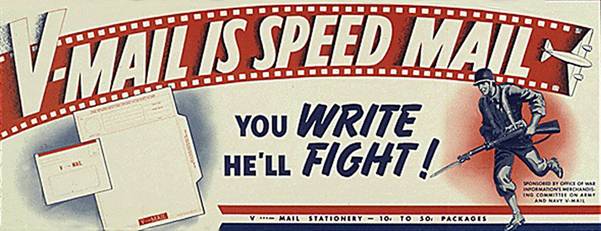
Makes it sound like Cause and Effect, doesn't it?
poster illustrating V-Mail stationery
veteran-voices.com
In 1942, the fountain pen was as ubiquitous as the cell phone is today. Thus, one constraint which V-Mail respected was that Americans, whether at home or at war, would continue to write letters using their fountain pens. A corollary was that the letters they received would appear "as written" (i.e., in the familiar handwritings of those who had sent them). As the illustration above suggests, for the sake of morale, it was essential that the recipient immediately recognized the sender's handwriting, and felt the connection it triggered. How did it work?
V-Mail letters had to be written on special stationery. Any fountain pen could be used, as long as it was filled with an opaque black ink. When mailed, the letter first was routed to the closest military post office facility. There, it was reviewed by censors, and sorted according to where the recipient was currently stationed. All V-Mail letters that were headed to the same military post office were gathered together for microfilming. Once developed, the reel of 16mm film was packaged, labeled, and forwarded. The receiving APO (at that time, military post offices were all called Army Post Offices) had equipment that printed all the spooled microfilmed V-Mail. The resulting paper letters, somewhat smaller than the originals, were then dispatched for delivery. The process for letters written home from the front was the same.
The hand-written paper V-Mail letters were retained until the sending APO was notified they had been delivered. If a roll of microfilm was lost or damaged before its letters could be delivered, the originals were re-microfilmed, and the process repeated.
One mailbag of microfilm reels was the equivalent of perhaps 40 bags of regular mail, and weighed only about 2% of the equivalent paper. Considering the great distances many letters had to travel, the fuel savings were immense.
*
Meanwhile, an independent but parallel problem had arisen. In effect, every U.S. soldier used a fountain pen, but old Army regulations made it hard to carry one if you were in uniform: the flap on your shirt pocket had to be buttoned closed. If you clipped your pen in your pocket - a necessity for almost all fountain pens, which had to be stored upright to prevent their nibs from clogging - the flap would not close properly. Thus, pen-makers had to redesign their pens and mechanical pencils because of the war.
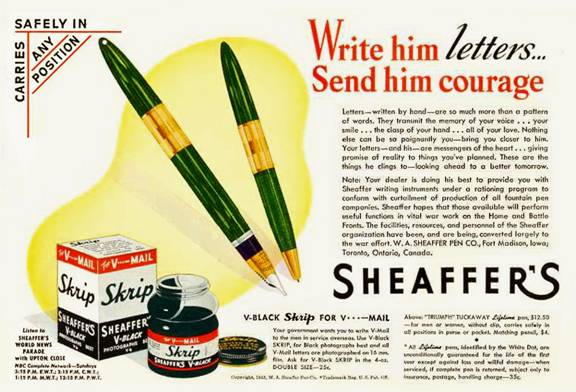
Because of the big flap about pocket-flaps, some pen companies designed
top-mounted "military clips" that permitted flaps to be closed over them.
Instead, Sheaffer's eliminated clips, and modified the ink flow mechanism
so that nibs would not clog, regardless of how their new pens were stored.
Note the terminology: V-Mail referred to Victory,
and the new Sheaffer model was the Triumph
advertisement in National Geographic, May 1943
***
Civilian Defense
In the quarter century between August 1914, when a Zeppelin dropped bombs on two Belgian cities, and September 1939, when the Luftwaffe strafed helpless Polish civilians who were fleeing an invading army, air raids against civilians had become an accepted part of warfare. Thus, in anticipation of America's] joining the war, the U.S. established the Office of Civilian Defense (not a typo) in May 1941. It existed to prepare Americans for the prospect of facing enemy attacks at home, and it primarily focused on air raid readiness. Americans would be instructed in two protocols: the Blackout, and the Air Raid Drill.
*
Blackouts
In 1941, flying long-distance bombing attacks was far more dangerous than flying shorter missions - the small, agile fighter aircraft needed to protect bombers simply could not carry enough fuel for long missions. It was safer to fly long distances in the dark, when your bomber was less visible. Thus, America believed that any long-distance enemy air raids on the 48 states would occur at night. Hence the concept of the Blackout, intended to darken an area so completely that enemy aircraft could not find the targets they sought.
The U.S. codified rules for Blackouts in 1942. Outdoor lights (signs, street lights, etc.) were to be extinguished. If a traffic light had to be left on, its lenses were to be shielded, rendering them invisible from above, and minimizing the light they cast below. Civilians needed special authorization to operate vehicles during Blackouts, and those vehicles had to be modified, as illustrated here:
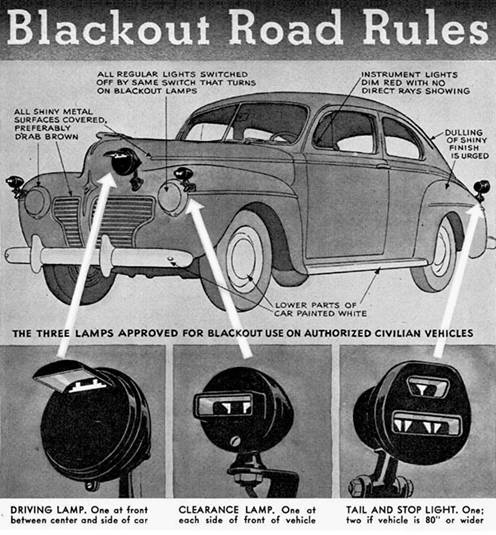
Popular Science, September 1942
All powered vehicles (trucks, ambulances, police and fire vehicles, etc.) were subject to similar rules. Horse-drawn vehicles, pushcarts, and bicycles got their own rules, too. Pedestrians who had to be outside during Blackouts could carry no lighted matches, cigarettes, etc.; they had to wear dark clothing, preferably with white visibility wraps around their calves (so that drivers could see them); flashlights had to point straight down when in use.
Either indoor lights had to be turned off, or all windows in the rooms they illuminated had to be covered by light-tight material. During a Blackout, violations of these rules were enforced by Air Raid Wardens (see below) and, as necessary, by police.
*
Air Raid Drills
An Air Raid Drill might occur at night (and thus include a Blackout) or in the daytime. Any people who happened to be indoors were to take shelter wherever they were. Those who were outdoors had to proceed home or to public shelters, whichever was closest. Entrances to designated public shelters were marked with yellow signs. These shelters were usually below ground, and in schools, apartment buildings, or office buildings. Their chief purpose was to protect the people within against airborne debris from explosions, especially shards of window glass. Home cellars worked well. If a home lacked a cellar, a first-floor shelter area could be improvised beneath a large table (see below). Again, the main idea was to avoid citizens' being blinded or otherwise injured by flying glass.
Air Raid Wardens were essential. They cleared the streets, directing people to, and if necessary helping them into, shelters. The volunteer Wardens had gone through a standard training program and passed a final exam. They knew First Aid, Blackout and Air Raid protocols, how to recognize a variety of poisonous gases, coordinate with emergency services, and identify military aircraft, both domestic and foreign.
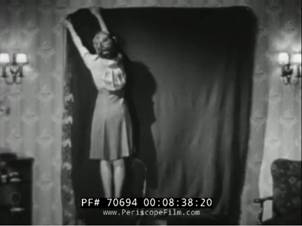
A woman hangs opaque fabric over her windows, so that her home's lights
cannot be seen from outside. Meanwhile, her husband puts a stuffed chair
between a window and the table under which his family will take shelter, to
block any shards of window glass sent flying by exploding bombs.
Yes, this was the domestic version of the "take cover"
school drills during which we ducked under our desks.
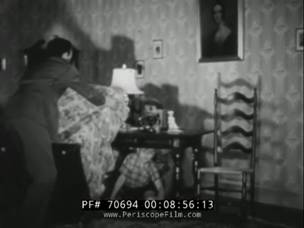
Both stills above are from an educational short by
Castle Films - narrated by Joe O'Brien, later a
WMCA Good Guy - which can be seen at
https://archive.org/details/70694CastleFilmAirRaidWarning
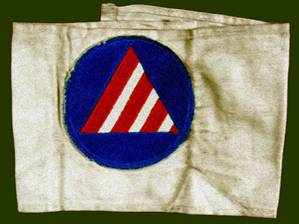
Wardens' helmets and armbands bore special logos - equilateral
triangles in red and white, contained in blue disks. Some
triangles had stripes, as shown above; others said 'CD.'
griffinmilitaria.com

The Air Raid Warden's job could be dangerous, especially in the dark. From a news
story about the extensive blackout tests that were conducted the
previous night in many parts of Long Island
The Brooklyn Eagle, May 15, 1942
***
Press Wireless
Vicky Penner Whitaker, HHS 1958, emailed me in response to last month's article, and shared with me some childhood memories of life in wartime Hicksville. She mentioned being with her mother and grandmother as they used their Ration Stamps at the old A&P on the east side of Broadway at Herzog Place, near the bank buildings. She also recalled the special blackout shades that her mother would secure. Her family's shades were considered unusually important because the Penners lived next door to Press Wireless.
What was Press Wireless? This anecdote may give you some idea of its role:
Five days after D-Day, a special radio installation on Long Island received the first direct wartime radio transmission from the Normandy beaches. Over the next seven days, 200,000 printed words from various war correspondents followed, and American media were able to report about post-invasion developments almost as soon as they happened. This direct reporting from Normandy was Press Wireless's idea, and it was accomplished by PW people, using a PW transmitter and other PW equipment made in Hicksville.
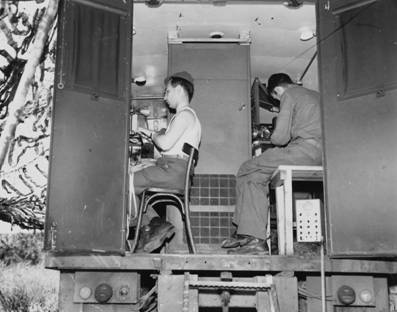
Two technicians of the broadcasting crew working in the
transmitter truck at Normandy, July 1944; note the camouflage
netting draped over the truck's left side
www.tmchistory.org/PressWireless/Prewi_company_history.htm
Getting news so soon seemed miraculous to the public, and if the public had known the details, it would have seemed even more so. Thanks to a U-boat, one of the mobile 400W transmitters made by PW had not made it to Europe. The one that was sending news back home had made it to England, then had crossed the rough Channel in an LST, and bounced ashore through the surf and sand in an Army truck - and it still worked. Now the truck was parked near some trees in a pasture, draped in camouflage netting, sending news that was relayed across America. Despite months of planning, PW had not yet been granted a dedicated radio frequency for the new station, so the lead station operator improvised. He chose a frequency already assigned to PW and certain news media for other purposes. Across the Atlantic, someone picked up the transmission, realized what was going on, and everyone involved agreed to keep that frequency clear for the Normandy station.
There's room here for only a brief overview of PW and everything it did.
As radio became established in the 1920s, "paper news" publishers began working together to establish a radio-based infrastructure by which news could be disseminated quickly and fairly. By 1931, the effort had morphed into Press Wireless Corporation, a public utility. A large transmitting site was established in Hicksville, and a site for receiving was created in Little Neck. In less than a decade, the bulk of transmitting had moved to a 500-acre site in Centereach. The Hicksville site (now probably smaller than before) then served multiple purposes, including the manufacture of special-purpose equipment for internal use and for corporate and military clients.
Eventually, PW had operational offices in 62 countries; most of them used teleprinters. Generally, these devices turned text radio signals into printed language in a variety of languages, using the appropriate alphabet (or, in the case of Chinese or Japanese, the appropriate characters). Special teleprinters turned radio fax signals into printed images. PW's global network earned praise from its clients for dependability.
During the War, both the news and military work (the latter coordinated through the U.S. Signal Corps) that PW did were of high priority. In addition to enabling media to report on what was happening, Hicksville produced the long-distance transmitters and Dual Diversity Receivers* that the military needed to coordinate operations over large areas. Secondarily, Hicksville also became the broadcast point for relaying Voice of America programming to Europe via short wave.
*In simple terms, a Dual Diversity Receiver uses a combination of circuitry and multiple antennas to maximize the clarity of signals that would otherwise be distorted by having bounced off distant buildings, cliff faces, etc. This is exceptionally important when transmissions are sent from low ad hoc locations near, say, battlefields.
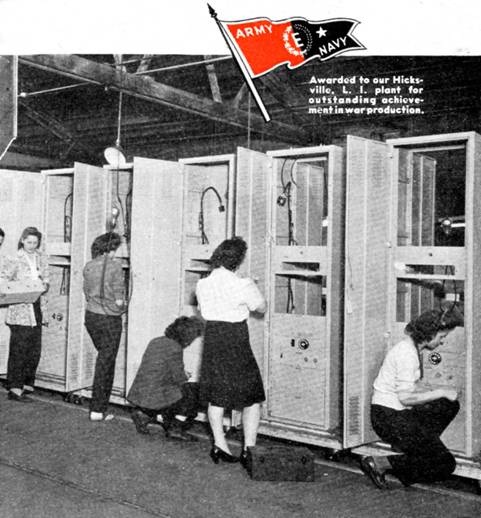
Employees of Press Wireless in Hicksville, constructing
advanced Dual Diversity Receivers for use by the U.S. Army
The pennant signified that a given factory had received an Army-Navy E Award,
in honor of "Excellence in Production." Far fewer than 5% of all defense plants
were honored in this way. The star visible on this pennant signified that the plant
had been honored again, for sustaining excellence after first receiving the award.
advertisement in Electronics, May 1944
There is much more that could be said about Press Wireless. If you're interested in reading further, please go to https://www.tmchistory.org/PressWireless/Prewi_company_history.htm
***
The Dairt Company
As we saw last month, wartime government agencies redirected corporations to make different products (for example, to build aircraft engines instead of cars). Such redirection was not limited to industrial giants. Mid-sized companies also had niches to fill, as when a company that made wristwatches instead made navigation instruments for the U.S. Navy. Even small manufacturers got defense contracts. Thus, it was not very surprising when a factory on Duffy Lane (the road had not yet achieved "Avenue" status) stopped canning mushrooms, and was taken over by The Dairt Company, Inc. to manufacture "reloaded" ammunition - military-grade .45 caliber bullets, made from used brass cartridge casings.
If people in Hicksville noticed the change, they might have been concerned - after all, cans of mushrooms rarely explode. Such people would have been right to be concerned, even outraged, but for the opposite reason: a lot of the bullets made in that factory would never explode.
Published details of the Dairt experience are scant, but one can safely say that its tale made no one proud.

Note: "Little Norway" was a wartime camp in Ontario, used for training
the military of the Norwegian Government in Exile. Many of those at the
camp were members of the Norwegian air corps, who were being trained
to fly and maintain contemporary military aircraft.
Note that the charges described here relate to Mail Fraud - a sometimes effective but last-ditch backdoor, by which the U.S. government targeted criminal activities that were impossible to prosecute directly. The stratagem is loosely comparable to sending Al Capone to prison for tax evasion, rather than for his ordering many murders, because witnesses to his murders were afraid to come forward. In this case, it appears that Dairt was not being charged for criminally manufacturing faulty ammunition and selling it to America's allies. Rather, it was being charged for sending through the mail correspondence that misstated the quality of said ammunition.
Obviously, the apparent character of some of the people charged is not impressive. Most had enough past involvement with the criminal justice system to be considered questionable.
Plant Manager Moe Saraga, whom testimony later alleged once had said he did not care if the bullets made in the factory did not work, was known in underworld circles as Luger Joe. Testifying in unrelated previous cases, he had admitted selling guns to the Dutch Schultz mob. He had been convicted of failing to record gun sales, so as to make guns used in certain mob murders harder to trace. He had supplied guns to New Jersey criminals who participated in what was seen as a "union war," in which organized crime hoped to back and corrupt the victorious union.
Alas, not much more was said about this case in the press. It came to trial in November 1943, and was over before Christmas. The accused maintained that they had not known that any bullets were defective (even though the former foreman at the plant testified that he had reported that many were). After evaluating the testimony, the judge directed that one of the accused be acquitted, as insufficient evidence of his participation had been presented. For whatever reason, the jury voted to acquit the rest on the mail fraud charges. Case closed.
***
When All Else Fails, buy Her a Fur Coat
It's a paradox. During the horrible years of the Great Depression, prices were low, but almost nobody had money. Now that it's wartime, most prices are capped by the government, and almost no one is unemployed. People have money. They can afford almost anything they want. If only if we didn't have all those shortages! We can never find the things we want to buy.
My wife's birthday is coming up, and this year I want to get her something special. Diamonds? No, they're not worth it right now. The price of diamond rings has quadrupled, because the Nazis have occupied all the diamond-cutting countries, silver and gold are in short supply, and the jewelry makers are either off in uniform or they're working in defense plants. Once the war is over, the price probably will just drop down again.
Hey, what about a fur coat? Not one of those squirrel or cheap dyed muskrat coats, like the department stores are carrying. You can't get European or Russian furs right now because of the war, but I'll bet that there still are other good options.
Hmmmm.... How much can I spend? What would be too much? Let's see... after buying those War Bonds, we still have enough money in the bank for a while, and I'm getting 90¢ per hour - that's three times the minimum wage, by the way - as a metalworker making airplanes. I think that I could splurge this year, and spend maybe $275 on a fur coat for her birthday. Let's see what the ads in the Times have to say... Well, will ya' look at this beauty. Perfect!

Nothing says "I love you" like a new fur coat!
New York Times, June 29, 1943
*
There's a lot more one could say about the Home Front, but this is where I'll leave things, at least for now.
I Wish You All a Great Thanksgiving
*****

